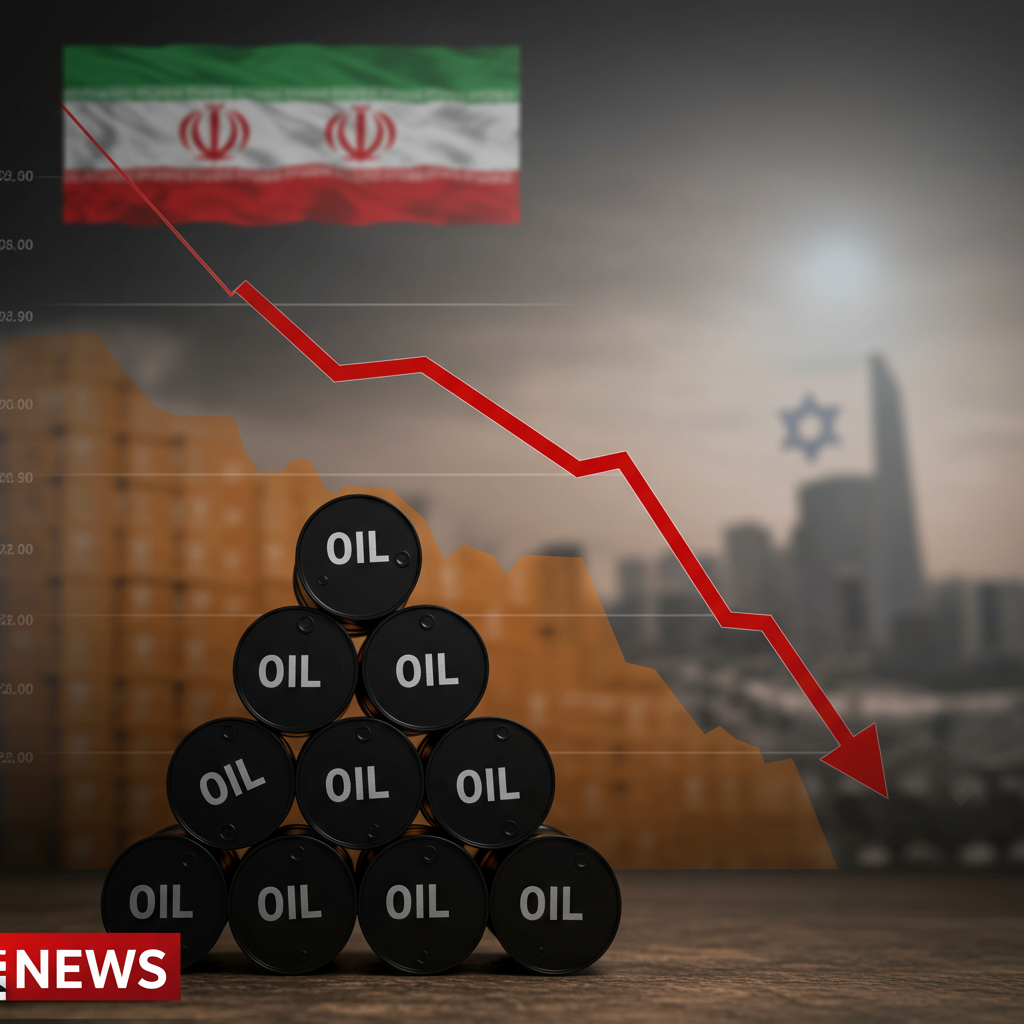Global energy markets are breathing a cautious sigh of relief following a recent pause in hostilities between Iran and Israel. After spiking to a five-month high amid escalating tensions, oil prices saw a sharp decline as a fragile truce appeared to take hold, signaling that the immediate threat to critical supply routes had lessened, at least for now.
Brent Crude, the international benchmark for oil prices, tumbled more than 5.6 percent in trading, settling around $66 a barrel. This significant drop came after Iran conducted a retaliatory strike on a US military base in Qatar, a move interpreted by many as a deliberate avoidance of direct economic warfare, such as closing the strategically vital Strait of Hormuz.
The Strait of Hormuz is a narrow waterway situated between Iran and Oman. It serves as a critical chokepoint, with roughly 20 percent of the world’s total oil supply passing through it daily. Beyond oil, it’s a key trade corridor connecting Europe and Asia. Any disruption to traffic through the strait would send a massive jolt through global markets.
While Iran’s parliament has previously backed proposals to close the strait, the final decision rests with the country’s Supreme National Security Council. Tehran has made similar threats in the past, notably during heightened tensions in 2018. A potential closure could involve deploying sea mines or attacking and capturing vessels, tactics seen during the Iran-Iraq War in the 1980s and more recently with Revolutionary Guard seizures of ships accused of smuggling.
Should the strait be closed, analysts warn of severe consequences for global markets. Forecasts suggest crude oil prices could surge dramatically, with some experts predicting prices could top $80 a barrel, while others forecast a jump potentially reaching $110. Although there is debate about whether existing global spare capacity could blunt the immediate impact, the risk of extreme volatility remains high, drawing comparisons to the energy market disruptions witnessed after Russia’s invasion of Ukraine in 2022.
Paradoxically, Iran’s strike on the US airbase in Qatar was viewed by markets as a calming development because it suggested that economic retaliation, such as targeting oil flows through the Strait of Hormuz, was not the immediate priority. As one analyst noted, if Iran were intent on severe economic impact, sinking an oil tanker in the Strait would be a more direct action, implying that the choice of a military target elsewhere suggested a degree of economic restraint.
Beyond the Immediate Conflict: Market Fundamentals
Even before the recent escalation, the global oil market was already navigating shifting dynamics. OPEC+, the alliance of oil-producing nations, had agreed in May to increase production by 411,000 barrels per day for July, part of unwinding output cuts implemented when demand plummeted during the COVID-19 pandemic.
Several factors could potentially mitigate the impact of any future supply shortage. OPEC+ members, primarily Saudi Arabia and the United Arab Emirates, hold significant spare production capacity. Estimates suggest they could quickly add about 2.5 million barrels per day to the market, with the potential for up to five million barrels over a longer term. This spare capacity could serve as a crucial buffer against disruptions.
Non-OPEC producers also play a vital role. Countries like Brazil, Canada, Guyana, and the United States have the potential to increase output. Experts point out that the US and Canada generally have a quicker response time to market needs compared to other producers. Non-OPEC supply has grown significantly over the past decade, and this trend is projected to continue, with forecasts indicating that as much as 90 percent of global oil production growth this year will come from non-OPEC sources. The United States also maintains a Strategic Petroleum Reserve (SPR), currently holding over 400 million barrels, intended for use during global supply emergencies, though refilling it would be a costly and multi-year undertaking.
Iran’s Oil and Global Connections
Iran contributes about 4 percent to the global oil supply. Due to international sanctions, the vast majority of its exports—nearly 90 percent, totaling around 1.6 million barrels per day—are directed towards China. Sanctions make it difficult for Iran to significantly increase its presence in the global oil market beyond existing arrangements.
The interconnectedness of oil markets means that price shocks originating from geopolitical events like a Strait closure would rapidly spread, impacting economies worldwide, including the United States and China. China, already navigating complex trade issues, would be particularly vulnerable to a sharp rise in energy prices. Interestingly, reports emerged suggesting a potential shift in US policy regarding China’s purchase of Iranian oil.
The Fragile Truce Takes Hold, But Uncertainty Lingers
The recent pause in hostilities, reportedly brokered with diplomatic efforts involving the United States and regional partners like Qatar and Egypt, offered markets a moment of calm after nearly two weeks of conflict stemming from Israeli strikes on Iranian nuclear facilities and subsequent Iranian retaliation.
However, the truce proved instantly fragile. Reports surfaced of violations from both sides just hours after it was meant to begin. Conflicting accounts emerged, with Israel claiming retaliatory strikes for alleged Iranian violations after the ceasefire started, while Iran denied firing any missiles post-truce and accused Israel of being the aggressor. This immediate breach underscored the delicate nature of the de-escalation efforts.
Claims about the effectiveness of the initial strikes on Iran’s nuclear program also remain highly contested. While Israeli and some US officials claimed significant setbacks or even destruction of key facilities, a leaked US intelligence assessment reportedly suggested the damage might only result in a delay of a few months to Iran’s program, with critical stockpiles and infrastructure potentially surviving the attacks. Iran, for its part, asserted that the strikes failed to achieve their objectives and declared its nuclear program would continue, even with greater determination.
The temporary easing of tensions also had a positive impact on markets beyond oil. Airline and travel stocks, particularly in Europe and the UK, saw a notable surge as investors anticipated fewer disruptions to international air routes and stable fuel costs. Broader global equity markets rallied, while gold prices dipped, reflecting a general return of cautious optimism among traders sensitive to geopolitical risks. Regional airspaces, previously restricted, also began to reopen.
Amidst the political posturing and conflicting narratives surrounding the truce violations and the impact of the strikes, the human cost of the conflict was also evident, with reports detailing casualties on both the Iranian and Israeli sides.
For now, the global oil market and broader financial systems have reacted positively to the perceived step back from the brink of further escalation. However, the immediate violations and the deep-seated tensions underscore that this pause is extremely fragile. The situation remains fluid, and the risk of renewed volatility driven by geopolitical events in the region continues to loom large.



